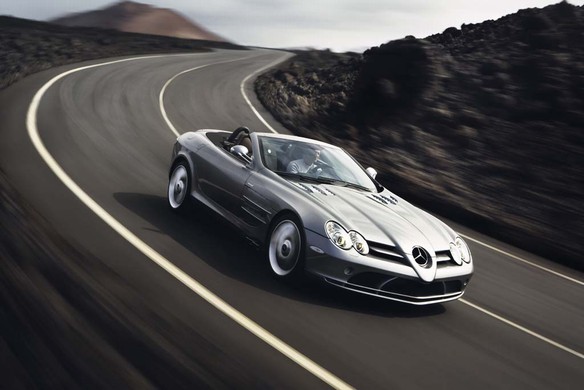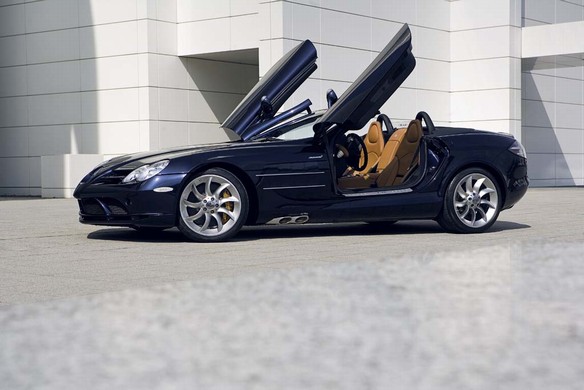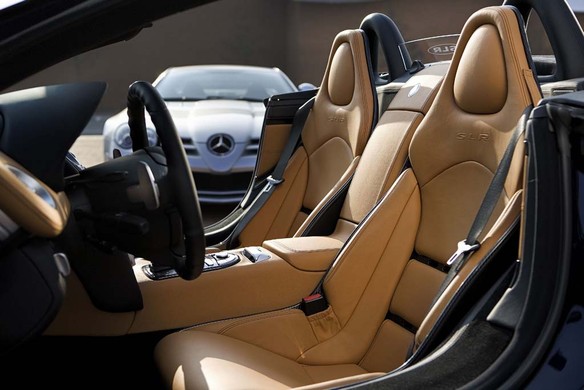Mercedes-Benz SLR McLaren Roadster

An open-air adventure for all the senses

Mercedes-Benz will in future also market its SLR McLaren super sports car in the form of a roadster with a top. In common with Formula 1 vehicles of today, it, too, will be made of carbon fibre, a material that will endow the vehicle with a very high degree of safety as well as extreme torsional stiffness at the same high level as the coupe version. This gives rise, in combination with the racing-type chassis, to outstanding ride characteristics. The maximum speed of the new high-performance sports car, which is powered by an AMG V8 compressor engine delivering 460 kW/626 hp, is 332 km/h, therefore at the same high level as the coupe. Although, thanks to its fully retractable top, the Roadster offers undiluted open-air driving pleasure in the highest performance class, its occupants in no way lose out in terms of comfort or the vehicle’s suitability for everyday use. Consequently, the new Roadster opens up a new dimension in refinement for open-top super sports cars.
Like the coupe version, the new Mercedes-Benz SLR McLaren Roadster once again unites the legend of the successful SLR racing models from the 1950s with the innovative technology of modern Formula 1 vehicles from the Vodafone-McLaren-Mercedes team. Typical stylistic elements, such as the arrow-shaped tip of the Formula 1 Silver Arrow, establish a visual link with the racing cars. The SLR leg-end of the 50s lives on stylistically in the distinctive lateral louvers, side pipes behind the front wheels and the wide-opening gullwing doors.

The new Roadster benefits technically from the many years of experience of Mercedes-Benz and its Formula 1 partner McLaren. Apart from two aluminium engine frames, its body is made entirely of carbon-fibre reinforced plastic (CFRP) materials, making the vehicle an exception among high-performance sports cars. Especially for the Roadster, complex carbon-fibre technology has been intelligently further developed for the monocoque chassis. The result is low weight, exemplary energy absorption and, therefore, extremely high occupant safety as well as a degree of torsional stiffness hitherto unattained in open-top vehicles. This leads to outstanding ride characteristics of the kind otherwise found only in closed-top super sports cars.
The puristic top is suitable for high speeds

The exceptional qualities of the Roadster are attributable also to the fully retractable top, which blends harmoniously into the flowing lines of the SLR McLaren. Its newly developed roof material, which is available in three different colours, not only guarantees complete suitability for everyday use in all weathers, but also endows the high-performance sports car with characteristics that are exception-ally unusual in a roadster. For example, at 332 km/h, the maximum speed is at the high level of the coupe version. Conversation is still possible at well over 200 km/h on open-air journeys thanks to the favourable aeroacoustics.
The roof opens and closes semi-automatically in less than ten seconds, thereby combining the desire for convenience with the puristic character of the roadster. To open, the roof merely needs to be unlocked from the windscreen frame and be briefly raised, after which it folds away electrically. Since an aluminium cover is integrated into its front section, the roof elegantly closes off the top when re-tracted.
Sophisticated aerodynamics and racing-type chassis

In the wind tunnel, the Roadster has been optimised for high speeds with regard to handling, aeroacoustics and aerodynamics. It likewise employs the aerodynamic concept already known from the coupe version, featuring an airbrake integrated into the access lid and a diffusor in the rear bumper to provide increased downforce on the rear axle.
The open two-seater is equipped with a racing-type chassis featuring high-performance carbon-ceramic brake discs, thereby setting extremely high stan-dards. Its front-mid-engine provides for optimum weight distribution. With 460 kW/626 hp and a maximum torque of 780 Nm, the AMG V8 compressor engine, which is coupled to an AMG Speedshift R five-speed automatic transmission, accelerates the Roadster from zero to 100 km/h in 3.8 seconds.
Unique safety and exclusive fittings
A high degree of safety is ensured by unique carbon-fibre crash elements, steel-reinforced A-pillars and two fixed roll-over bars. The comprehensive specification also features adaptive airbags, knee and side airbags as well as seat belt tensioners and a tyre-pressure monitoring system.
The exclusive standard equipment includes semi-aniline-leather-upholstered carbon-fibre bucket seats which can be individually adapted to the driver and front passenger by means of differently sized seat pads; dual-zone automatic air-conditioning; a high-quality BOSE premium sound system; a multifunction sport steering wheel with gear-change paddles, and a navigation system with integral radio and CD player.
The new Mercedes-Benz SLR Roadster, like the coupe, is produced at McLaren’s Formula 1 factory in Woking, England, in accordance with stringent Mercedes-Benz quality criteria and will be available as from September 2007.





